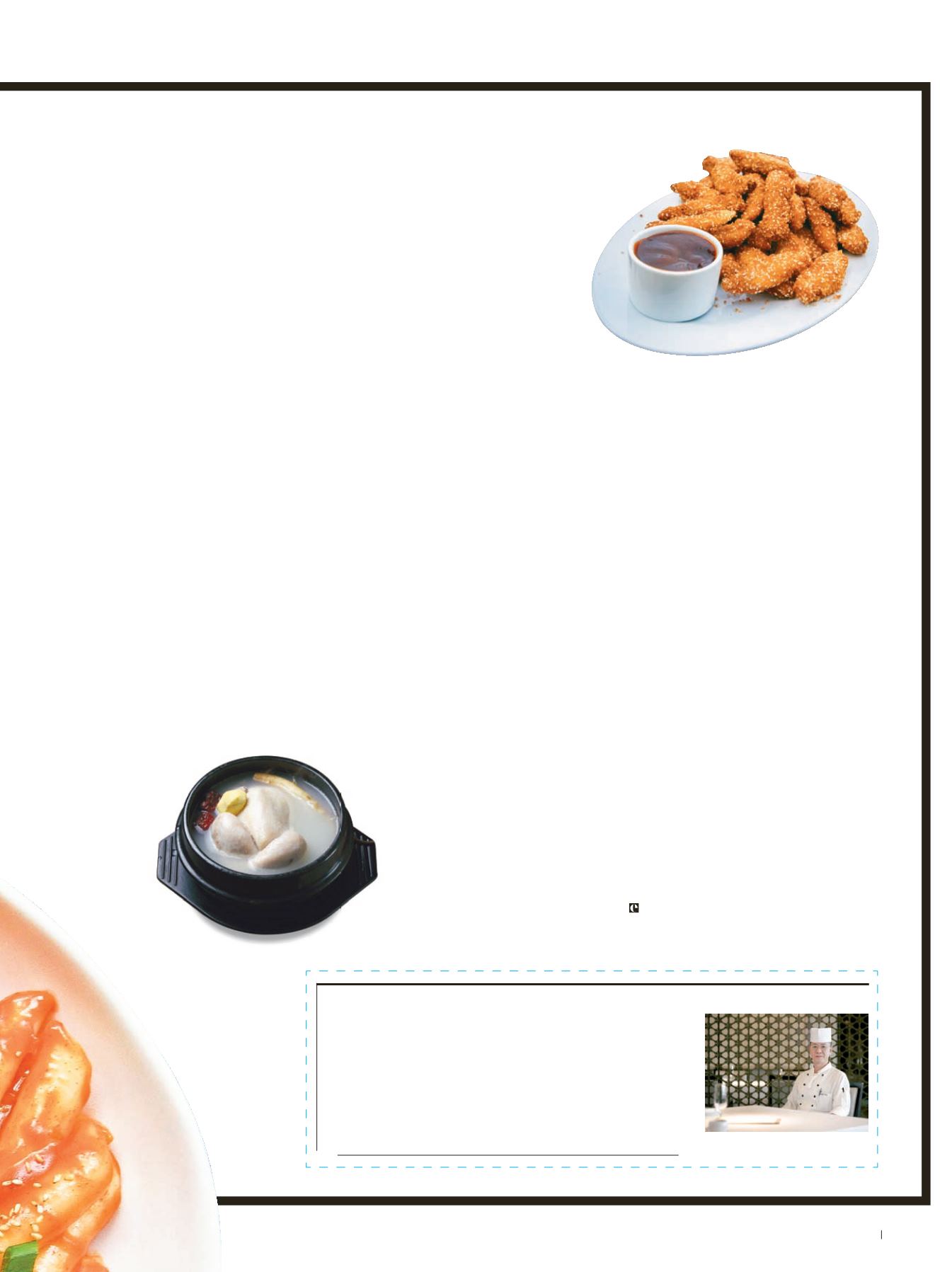
Restaurant: La Yeon
Located on the 23rd floor of The Shilla Seoul, La Yeon features
authentic Korean haute cuisine alongside views of downtown Seoul.
Diners can choose from four different set menus with creative
interpretations of classic recipes made with seasonal and locally
sourced ingredients. Try the Royal Hot Pot, an imperial-inspired dish
accompanied by seafood, premium Hanwoo beef, and vegetables. La
Yeon was named one of Asia's 50 Best Restaurants in 2015 and 2016.
µ
ā
FINE DINING IN SEOUL
ā
carbonara,
ramyeon
noodles, or served on skewers. Head to the
Sindang-dong neighborhood of Jung-gu, Seoul, a popular
shopping area known for its Tteokbokki Town, the place where
the dish originated, and where you can still find several
tteokbokki establishments, each with its own unique recipe.
CHIMAEK
A compound word derived from “chicken” and
maekju
(beer),
chimaek
restaurants serve chicken and beer throughout the
evening and into the late night. There are many different varieties
of chicken, including sweet and spicy, boneless tenders, and soy-
sauce flavored. For a special dining experience that you can only
get in Korea, have a fried chicken picnic in the park. At any of
the parks around the Han River, you’ll find people lined up at the
nearby subway exits to pass out flyers with the menus of nearby
restaurants. Call the place you want, order your chicken and beer,
and they will deliver it to your location in the park.
SAMGYETANG
Korean-style chicken and ginseng soup, or
samgyetang
, is
prepared with a whole young chicken stuffed with Korean
ginseng, sweet rice, garlic, and jujubes. Visitors may be surprised
to learn that this warming soup is particularly popular on the
hottest days of summer because of the conventional Korean
wisdom to “fight heat with heat.” Not only is the soup said to
help dispel the heat, but it’s also believed to boost energy and
help prevent illness.
GIMBAP
Made with a sheet of dried laver seaweed (
gim
) wrapped around
white rice (
bap
) and other ingredients,
gimbap
is popular with
school-aged children and often eaten as a light meal or taken for
picnics. The dish is similar to Japanese nori-wrapped sushi rolls,
which were introduced to Korea during the Japanese occupation,
but instead of the vinegar-seasoned sushi rice and fresh seafood,
gimbap uses sesame oil and more cooked or preserved
ingredients such as kimchi, seasoned beef, eggs, cheese, pork
cutlet, canned tuna, and luncheon meat.
BINDAETTEOK
This is a savory pan-fried pancake made with ground mung
beans, kimchi, and green onions, peppers, or other vegetables.
Meat (generally beef or pork) may also be added, and the dish is
served with a dipping sauce made with green onions, chili pepper
flakes, soy sauce, and vinegar. A great place to try
bindaetteok
is
Gwangjang Market, one of the largest and oldest traditional street
markets in the country.
TTEOKBOKKI
A traditional Korean street food,
tteokbokki
is made from chewy
rice cakes in
gochujang
, a spicy red chili paste, along with
onions, garlic, and scallions. Other ingredients are often added,
including fishcakes, boiled eggs, fried vegetables, cheese,
sausages, noodles, and pan-fried
mandu
(Korean dumplings).
Due to its popularity you can find many creative variations of the
dish, such as rice cakes cooked with seafood, curry, cheese,
PHOTOGRAPHY: GETTY IMAGES / TOP PHOTO GROUP / SHILLA HOTELS & RESORTS
29
enVoyage


